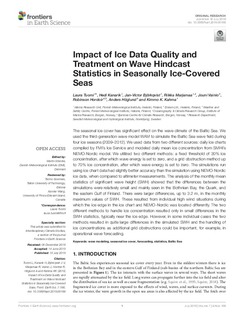| dc.description.abstract | The seasonal ice cover has significant effect on the wave climate of the Baltic Sea. We used the third-generation wave model WAM to simulate the Baltic Sea wave field during four ice seasons (2009–2012). We used data from two different sources: daily ice charts compiled by FMI's Ice Service and modeled daily mean ice concentration from SMHI's NEMO-Nordic model. We utilized two different methods: a fixed threshold of 30% ice concentration, after which wave energy is set to zero, and a grid obstruction method up to 70% ice concentration, after which wave energy is set to zero. The simulations run using ice chart data had slightly better accuracy than the simulation using NEMO-Nordic ice data, when compared to altimeter measurements. The analysis of the monthly mean statistics of significant wave height (SWH) showed that the differences between the simulations were relatively small and mainly seen in the Bothnian Bay, the Quark, and the eastern Gulf of Finland. There were larger differences, up to 3.2 m, in the monthly maximum values of SWH. These resulted from individual high wind situations during which the ice edge in the ice chart and NEMO-Nordic was located differently. The two different methods to handle ice concentration resulted only in small differences in the SWH statistics, typically near the ice edge. However, in some individual cases the two methods resulted in quite large differences in the simulated SWH and the handling of ice concentrations as additional grid obstructions could be important, for example, in operational wave forecasting. | nb_NO |
